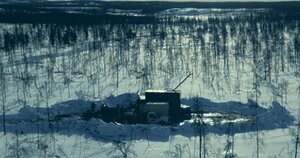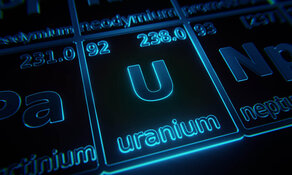The Energy Report: In your last interview, "The Uranium Industry Is Alive and Well," Germany and Japan looked determined to shift away from nuclear power. Now, it looks like Germany is having second thoughts on its plans to shut down all nuclear plants by 2022, and Japan has restarted one reactor, with more to come. What's your general industry view at this time?
David Talbot: We are still bullish on the uranium sector because the nuclear power industry is moving forward and demand is behaving somewhat predictably. Supply will make all the difference in the world. The U.S./Russia Megatons to Megawatts program will go off-line in 2013, which will remove 24 million pounds (Mlb) of secondary supply from the equation. Meanwhile, there are five more reactors in the planning or construction phases globally than there were before the disaster at Fukushima occurred. There are 430 reactors currently in operation worldwide, and 160 reactors are being planned now. The trend is clear: There is still growth in nuclear power.
On the supply side, the world uses 176.7 Mlb of uranium each year, according to the World Nuclear Association. The reactors under construction alone will account for a 13% increase in demand, approaching 200 Mlb of uranium required annually. This does not factor in any reactors in the planning stages. Mining companies are not matching that in the short to mid-term—they need higher uranium prices to make larger-scale and typically low-grade projects economic, and miners are optimistic that will happen. Uranium exploration expenses rose to about $2 billion worldwide last year.
As for Germany, its demand accounts for only 9 Mlb a year, or about 3% of world demand by 2020. I believe its government did overreact, and it is apparently having second thoughts, based on economic realities. We don't think Germany's opinion on nuclear power has changed much. But the country is struggling with rising electricity prices and facing pressure from industry. Finally, China matters. Its 15 reactors now produce just 2% of its electricity, and there are 26 reactors under construction and 51 more planned. Last year, China produced only 10% of the electricity that the U.S. reactors produce. It already uses 17 Mlb per year, and that figure is climbing quickly and should be in line with U.S. figures in the next seven years. Chinese demand is a major force driving the industry. While we believe that renewables should be a growing part of the energy mix, they are intermittent generation sources and can't necessarily handle a large proportion of baseload demand. Many alternative energy sources are still in their infancy and expensive.
TER: So, despite the negative thoughts about nuclear power, it really is the only viable alternative to coal at this point, other than natural gas.
DT: I think so. We are seeing a lot more natural gas use these days, primarily in Japan, which is spending about $100 million (M) a day on energy imports. If Japan wants to maintain its way of life, it really must turn the reactors back on or risk losing jobs. A couple of reactors have started up and two more restarts are under discussion. I think this is going to help boost sentiment in the sector and ultimately increase uranium demand, which should improve spot prices from the current U.S. $49.50/lb level.
TER: What are your expectations for short-term uranium prices? Even major companies like BHP Billiton Ltd. (BHP:NYSE; BHPLF:OTCPK) and Cameco Corp. (CCO:TSX; CCJ:NYSE) are having trouble justifying their respective Olympic Dam and Kintyre projects.
DT: The supply/demand balance in the mid-to-near-term may impact pricing. BHP announced a decision to delay expansion at Olympic Dam, by at least a couple of years. The initial expected expansions would have brought production up to about 20 Mlb from about 8.8 Mlb currently. Recently, Cameco warned that rising costs and mediocre uranium prices have made its Kintyre Project in Australia uneconomic. Cameco is still pushing ahead but needs around $67/lb to break even by the planned production start in 2015. That's another 6 Mlb of uranium supply up in the air. Cameco needs to make some acquisitions to reach its Double U strategy production goal of 40 Mlb by 2018, which would partially replace its lost Megatons to Megawatts supply.
Earlier this year, Paladin Energy Ltd. (PDN:TSX; PDN:ASX) postponed its stage-four expansion of Langer Heinrich until prices rise. That expansion would nearly double mine production from 5.2 Mlb to about 10 Mlb annually. These three projects alone total about 23 Mlb, which is 64% more uranium than Cameco's Cigar Lake is scheduled to produce annually. Each of these reminds us that many projects simply are not economic at current uranium prices and something has to give.
The current supply deficit should put upward pressure on prices, eventually making projects like Kintyre more feasible. We'll be lucky if annual uranium production reaches 180 Mlb by 2020. And that would require sustained spot prices of $70-80/lb. Our current forecasts for next year and 2014 are $70/lb and $67/lb, with a long-term forecast is $65/lb.
TER: How have the uranium stocks performed this year?
DT: Equities in general have really dropped off since the beginning of the year. As a group, uranium stocks are down about 30% year-to-date and much of the downward action occurring within the last 3-months. These companies have been under the same pressure as the broader market, with low liquidity and European debt worries. In the long term, I think the producers will outperform developers. But over the past few weeks we've seen some movement in the smaller stocks, with no clear winner between producers, developers or explorers. But however harsh the market is, you have to pick good stories, and right now we have a couple of suggestions for each of those categories.
TER: Paladin Energy has been showing some pretty exciting production results, but the stock has continued to languish and now there are some takeover rumors floating around. What's the situation there?
DT: Paladin is our top producer pick. We have a Buy rating on the stock with a $2.65 target price. Right now, we like what we see. We think the company has really turned the corner with good production numbers, a strong outlook, resource growth, advancement of the pipeline, asset sales and strategic alliances that are expected shortly. Those alliances could not only improve the balance sheet, but it could also add value to the projects that are still in the pipeline.
A Bloomberg article last month suggested that Paladin is a takeover target at these levels. We think that potential acquirers could include Cameco, Rio Tinto Plc (RIO:NYSE; RIO:ASX; RIO:LSE; RTPPF:OTCPK), Uranium One Inc. (UUU:TSX) or other senior miners looking to get into the uranium space. We have a Buy rating on Uranium One and a $4.50 target price. But I think that Paladin is going to make the first move with strategic alliances before anything else happens.
TER: What do you think is the most likely strategic alliance?
DT: There is probably going to be a JV at Mount Isa in Queensland, Australia. That's a potentially large operation that could produce about 5 Mlb annually but it's going to have a big price tag, probably well over $500M. I could see Paladin selling a minority position in this project to raise upwards of $350M, bringing in a partner that's responsible for its share of capex. That would help decrease financing risks and the cash generated could really take a bite out of Paladin's debt. The other possibility here is a strategic alliance to tap some value at the mine level. Kayelekera and Langer Heinrich are two of the very few uranium mines built anywhere in the world over the last 20 years and are now running at or near capacity. I'm sure there's an Asian utility somewhere that would jump at the opportunity to share ownership of one of these mines through an offtake agreement and have access to production over the next 25-30 years.
TER: There's also been some M&A action here in the U.S. In April, Energy Fuels Inc. (EFR:TSX) made a deal to acquire all of Denison Mines Corp.'s (DML:TSX; DNN:NYSE.A) U.S. mining uranium mining assets and operations. Where has that gone since then?
DT: Energy Fuels has emerged from a couple of deals as the second-largest uranium producer in the U.S., with a resource base of 70 Mlb. We have a Buy rating on the stock and a $0.90 target price. They bought the White Mesa mill from Denison, which is the only operating conventional mill in the U.S., plus several operating mines. This saved Energy Fuels about $150M by not having to construct its own mill, where it just received its NRC license in Colorado. Synergies with projects in Utah, Colorado and Arizona might fill that mill, keeping costs as low as possible. That's very important because these smaller mines in the Southwest U.S. tend to have higher operating costs.
We view Energy Fuels as a good opportunity with cash flow and significant leverage to rising uranium prices. It's preparing its pipeline of projects with two mines that are already permitted, Whirlwind and Energy Queen. Pinenut is also approaching production within the year. The management team has operating experience with the old Energy Fuels nuclear company, and its Sheep Mountain project up in Wyoming could bring this company to a whole new level.
TER: There's also been some takeover drama with UEX Corp. (UEX:TSX) and Cameco, as Cameco failed in their bid for Hathor. What's the latest on that situation?
DT: We have a Buy recommendation for UEX and a $1.85 target price. This is our favorite development story right now. Cameco did lose in its bid for Hathor and it needs to make an acquisition to meet its production goals of 40 Mlb by 2018, as we mentioned before.
UEX has projects in the Athabasca Basin and Cameco is its largest shareholder, with 23% of the stock. Earlier this year, Cameco put up a fuss when UEX attempted to implement a shareholder rights plan because Cameco really believed this would have breached some of its preemptive rights when UEX was spun off in the mid-2000s. Cameco participated in a UEX equity issue earlier this year, and failed to replace its UEX board representative when he retired. So there are signs that Cameco is still interested in UEX. But we aren't sure when a potential takeover can happen.
UEX's Hidden Bay has about 40 Mlb located about 4km away from Cameco's Rabbit Lake mill. An open-pit operation on that property could ultimately act as a tailings management facility, which is something Cameco's Rabbit Lake mill will need in the next few years. UEX also has 49% interest in the world-class 88 Mlb Shea Creek project to the west, which could easily be added to Cameco's pipeline. Cameco is probably the best company in the world to develop these high-grade, particularly deep deposits, and could potentially partner with AREVA (AREVA:EPA). UEX is one of our favorite developer stories, with high-grade drill results continuing from Shea Creek. In the short term, Hidden Bay is moving into development stages with geotechnical, geochemical and metallurgical studies underway.
TER: You initiated coverage in May on U3O8 Corp. (UWE:TSX.V; OTCQX:UWEFF). What do you like about that one? And why did you decide to start covering it now?
DT: We have a Buy recommendation and a Speculative Risk rating on U308 Corp., but no target price right now because we are awaiting a little more economic information to derisk this company a bit more. This is a small company with many moving parts. It has three projects, any one of which could likely sustain a junior exploration company. We picked up coverage as we became more excited about the upside potential offered by its multi-element flagship Berlin project in Colombia. The current resource only covers the southernmost three kilometers of a known 10 1/2 kilometer long sandstone trend. There's a misconception here that it's a black shale deposit. It's really a carbonaceous sandstone. That's a big difference. At 21 Mlb U308 plus byproducts, the resource has just started growing, with the potential to double and ultimately triple in a couple of years. Besides uranium, it will also be getting vanadium, phosphates, rare earth elements and base metals out of this calcite-rich rock.
Its second project, Laguna Salada, is located in Chubut Province, Argentina. Mineralization occurs within three meters of surface in soft, unconsolidated sandy gravel that should be amenable to low-cost mining techniques. The grades are very low but the geology lends itself to considerable beneficiation, in some cases by a factor of ten, which could boost the grades by ten times before it goes through the mill. While resources are currently only around 10 Mlb, there is potential to double this amount by year end through drilling, not to mention potential M&A targets in the area.
U308's third project is the Kurupung project in Guyana, which was once its flagship project. We still love its high prospectively with potential for hosting several massive uranium projects. However, exploration will be expensive and time consuming, plus U308 has two other projects in jurisdictions with better infrastructure. Those projects are likely to be advanced in the scoping study stages more expeditiously. Ultimately we think this is a very undervalued development story. The stock trades at about half the level of its peers, and we expect its resources to double during this year.
TER: What else do you like at this point?
DT: Another developer story I like is in Ur-Energy Inc. (URE:TSX; URG:NYSE.A). We have a Buy recommendation and a $2.30 target price on this stock. The timing might be right for investors on Ur-Energy. It's waiting for final U.S. Bureau of Land Management permits that would allow it to build and operate its Lost Creek Mine in Wyoming. The company expects to build a plant that could produce up to 2Mlb annually, starting at 1Mlb from Lost Creek with low operating costs of about $20/lb. We've liked this story for a while and think there's considerable upside. It's cheap, it's located in a good jurisdiction and it has good economics, good management and quite a deep technical team. It recently picked up a couple of good-looking projects from AREVA for its pipeline. Look for some news out of Ur-Energy in the next couple of months.
Among exploration stories; Kivalliq Energy Corp. (KIV:TSX.V) might be our top explorer pick now, with one of the best exploration teams in the business. We have a speculative buy without a target price on this one. Kivalliq is now drilling its Angilak property in Nunavut. The company seemed to have hit uranium mineralization in every place they've put a drill in 2011/early 2012 and surprised us by doubling its high-grade Lac Cinquante resource to 27 Mlb at 0.69% U308. This is one of the highest grades outside the Athabasca Basin. It's discovered about 10 new zones, many within 3km of the Lac Cinquante deposit itself. Others are located within 25km of the deposit and some of these are potentially big, like the BIF Zone that extends for about 3km along strike at surface, where grab samples often assay between 16% and 30%. As more discoveries are being announced, the company has to reprioritize its targets as it goes. We think they're in a uranium district and this story is going to be exciting to watch.
Another explorer that is front and center for us is Fission Energy Corp. (FIS:TSX.V; FSSIF:OTCQX). We have a Buy Venture Risk rating with no target price. The company has a project immediately west of Rio Tinto's Roughrider deposit in the Athabasca Basin. It's likely that Fission's high-grade J Zone discoveries are the same deposit as the Roughrider West Zones. The J Zone now measures about 680m along strike. We think there's considerable room to expand this, not only along strike but also to the north and south. Some impressive high-grade areas need follow-up there, including 15% U3O8 over 6m and 21.6% over 3.5m. It doesn't take a lot of area to add significant pounds when you're getting grades over 15%. That's one of the reasons why we like this company. The initial resource covers about one-third the strike length and totals about 9 Mlb. About 7.4 Mlb of that is Indicated, grading about 2%. Drilling continues on a second project to the west. That might end up as another Athabasca uranium discovery, if we give Fission sufficient time to search.
TER: What kind of timing are we looking at before we see some real activity in these stocks?
DT: We believe uranium prices may be at the bottom right now, around $49/lb.
We expect firming, especially as the Japanese reactors come back online. We may see some price appreciation later this year and into 2013 as the Megatons to Megawatts agreement expires. We are calling for higher uranium prices down the road, ultimately to our $65/lb long-term price. Investors have to pick good and improving companies before we see these stocks run. There's already a lot of volatility in the uranium sector but stocks tend to take off before you know it, so you can't necessarily choose cash flow over near-term production or potential blue-sky upside, as you can in a bull market. All the stocks will likely lift, but at different rates. Among producers, maybe look at Paladin and Energy Fuels; for developers, UEX, U308 Corp and Ur-Energy, and explorers, Kivalliq Energy and Fission Energy. We suggest that investors buy a basket of these stories. I really think this sector will be one that's going to outperform in the coming years.
TER: Very good. We appreciate your insights today David. Thanks for talking with us.
DT: Certainly. Thank you.
Dundee Securities Senior Mining Analyst David Talbot worked for nine years as a geologist in the gold exploration industry in Northern Ontario. Talbot joined Dundee's research department in May 2003 and in the summer of 2007, he took over the role of analyzing the fast-growing uranium sector. He is a member of the PDAC, the Society of Economic Geologists and graduated with distinction from the Univ. of Western Ontario, with an Honors Bachelor of Science degree in geology.
Want to read more exclusive Energy Report interviews like this? Sign up for our free e-newsletter, and you'll learn when new articles have been published. To see a list of recent interviews with industry analysts and commentators, visit our Exclusive Interviews page.
DISCLOSURE:
1) Zig Lambo of The Energy Report conducted this interview. He personally and/or his family own shares of the following companies mentioned in this interview: None.
2) The following companies mentioned in the interview are sponsors of The Energy Report: Energy Fuels Inc., U308 Corp., Ur-Energy Inc. and Fission Energy Corp. Streetwise Reports does not accept stock in exchange for services. Interviews are edited for clarity.
3) David Talbot beneficially owns, has a financial interest in, or exercises investment discretion or control over, companies under coverage: Energy Fuels Inc., U3O8 Corp. and Kivalliq Energy Corp. David Talbot was not paid by Streetwise Reports for participating in this interview.
Dundee Securities Ltd. and its affiliates, in the aggregate, beneficially own 1% or more of a class of equity securities issued by, companies under coverage: Energy Fuels Inc.
Dundee Securities Ltd. and/or its affiliates, in the aggregate, own and/or exercise control and direction over greater than 10% of a class of equity securities issued by, companies under coverage: U3O8 Corp.
Dundee Securities Ltd. has provided investment banking services to the following companies under coverage in the past 12 months: Energy Fuels Inc., U3O8 Corp., Kivalliq Energy Corp., UEX Corp., Ur-Energy Inc. and Fission Energy Corp.
All disclosures and disclaimers are available on the Internet at www.dundeecapitalmarkets.com. Please refer to formal published research reports for all disclosures and disclaimers pertaining to companies under coverage and Dundee Securities Ltd. The policy of Dundee Securities Ltd. with respect to Research reports is available on the Internet at www.dundeecapitalmarkets.com.








































